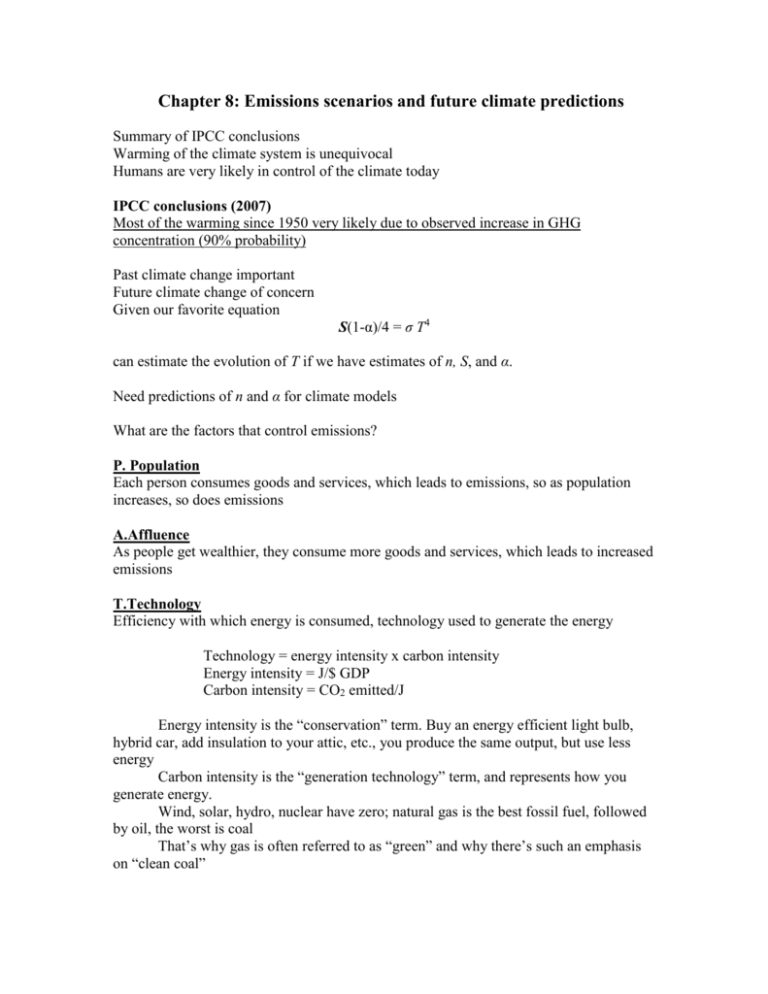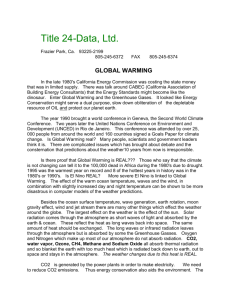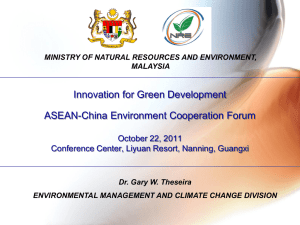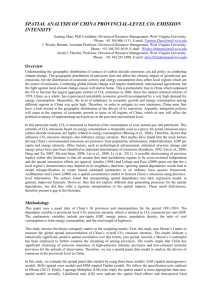chapter 8cc
advertisement

Chapter 8: Emissions scenarios and future climate predictions Summary of IPCC conclusions Warming of the climate system is unequivocal Humans are very likely in control of the climate today IPCC conclusions (2007) Most of the warming since 1950 very likely due to observed increase in GHG concentration (90% probability) Past climate change important Future climate change of concern Given our favorite equation S(1-α)/4 = σ T4 can estimate the evolution of T if we have estimates of n, S, and α. Need predictions of n and α for climate models What are the factors that control emissions? P. Population Each person consumes goods and services, which leads to emissions, so as population increases, so does emissions A.Affluence As people get wealthier, they consume more goods and services, which leads to increased emissions T.Technology Efficiency with which energy is consumed, technology used to generate the energy Technology = energy intensity x carbon intensity Energy intensity = J/$ GDP Carbon intensity = CO2 emitted/J Energy intensity is the “conservation” term. Buy an energy efficient light bulb, hybrid car, add insulation to your attic, etc., you produce the same output, but use less energy Carbon intensity is the “generation technology” term, and represents how you generate energy. Wind, solar, hydro, nuclear have zero; natural gas is the best fossil fuel, followed by oil, the worst is coal That’s why gas is often referred to as “green” and why there’s such an emphasis on “clean coal” IPAT = population x affluence x technology IPAT = CO2 emitted Population x wealth/person = total wealth of society = GDP = total goods and services produced/consumed by a society Technology = GHG emitted/$ = energy intensity x carbon intensity Renewables + nuclear are best; of the fossil fuels, natural gas is best, followed by oil; coal is the worst Energy required: PxA ; Energy intensity = # of Joules required Carbon intensity * energy required = amount of CO2 emitted Technology term also called “greenhouse gas intensity” - policy debates Recent historical data population: GDP, EI, CI Population + affluence is going up, EI and CI are going down Population has been rising for millennia EI and CI have both declined because 1) efficiency has improved because of price pressure 2) CI has improved as we move away from coal to nat. gas Rise in P and A faster than fall in EI and CI What about the future? For each of these terms, the IPCC has made predictions of “plausible” futures. They are not predictions, but “internally consistent storylines”: Terms are linked: Population is linked to affluence; technology is linked to economic growth Predicting the future A2 > A1 > B2 > B1 “A” scenarios are high growth (BAU) “B” scenarios are “sustainable”: limited growth “1” scenarios are “convergent”: narrowing gap between rich and poor “2” scenarios are “non-convergent” Feed emission calculations into carbon cycle model Carbon model is required to figure out how much CO2 stays in the atmosphere. Recall time scales for removal of carbon: about 50% removed within one year, about 80% removed after a few centuries, all removed after a few tens of thousands of years CO2 projections = economic + demographic model + carbon cycle model Carbon cycle model estimates how much the ocean and land take up A2 > A1 > B2 > B1 Can calculate total radiative forcing: [4-8]W/m2 C02 responsible for 80% of the forcing To calculate future temperatures, input C02 estimates above into climate models How much warming for each scenario? IPCC FIGURE Temp rise vs time (RHS = the year 2100) Recall: warming = 2-4°C, midpoint of about 3°C including fast feedback Committed warming of 0.5°C 1) uncertainties in the model, 2) uncertainties in the future emissions How do we compare with reality? We are at or above the “worst-case” scenario China and other developing countries (BRIC) are driving enormous increases in CO2 emissions due to coal: populations, wealth, reliance on dirty technology Long-term future warming: Emissions in the long run Carbon cycle slowly removes CO2 from the atm/bios/ocean system Fossil fuel use finite: note peak around 2100 Global surface temperatures in the long run Note peak around 2150 Actions we take will determine the climate for the next thousand generations Predictability of the climate Weather vs. Climate Requirements of a weather forecast: must predict the exact state of the atmosphere over the time frame If your prediction of rain is off by one day, it’s a blown forecast. If the prediction is off by 50 km, it’s a blown forecast The number one determinant of the weather tomorrow is the weather today. By “weather today” I mean the exact state of today’s atmosphere But there are errors in our specification of today’s state, and these errors grow, so that after about 1 week we can no longer accurately describe the exact state of the weather. For a climate forecast, we don’t care what the exact weather is on June 15, 2080 What we care is that the model gets the right statistics (distribution of temperatures, number of rain storms, etc.) for the summer of the 2080s. You don’t need to know the exact state of the atmosphere today for a climate prediction. Question: is Aug. warmer or cooler than Jan. in CLL? You just made a climate prediction months in advance, even though you cannot predict the weather 2 weeks in advance. For climate predictions, there is large year-to-year variability SHOW thermometer record We can predict warming in 100 years for the same reason we can predict that July is hotter than January.











